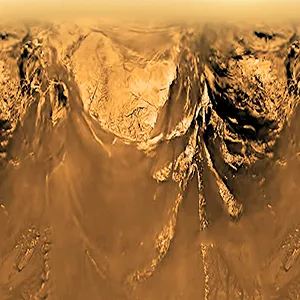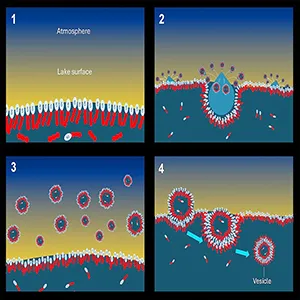In the search for life beyond Earth, few places are as intriguing as Saturn’s largest moon, Titan. It’s the only spot in the solar system where there are lakes and seas on the surface – only they’re not made of water.
Titan’s lakes overflow with liquid methane and ethane, producing a cold, bizarre, and mysterious world. Scientists have been exploring if life could emerge in such conditions.
Now, a new study from NASA offers a possible pathway for how tiny compartments called vesicles – which are critical in the early steps of cellular life – could naturally form in Titan’s frigid lakes.
Vesicles in Titan’s methane lakes
On Earth, life as we know it began in water. That’s where molecules came together in structures, got organized, and began to carry out the most fundamental functions of living cells. One of the first moves in this direction was the creation of vesicles.
Vesicles are small sacs, like tiny bubbles, composed of molecules with one end that adores water and the other that shuns it.
These amphiphiles arrange themselves spontaneously in the form of spheres in water, with the water-attracting parts pointing outward and the water-repelling parts safely inside.
Over time, some of these spheres developed a second outer layer, creating a bilayer membrane. This gave them the structure of a cell, able to enclose materials and protect them from the outside.
But Titan isn’t Earth. There’s no liquid water. The chemistry and environment are entirely different.
That’s what makes this research so interesting. It suggests that vesicles might still form – just not in water. Instead, they could take shape in Titan’s methane and ethane-rich lakes through a different, but equally natural, process.
Titan is a moon with weather
Titan isn’t just the biggest of Saturn’s moons. It’s also the only one with a thick atmosphere. The orange haze surrounding it is mostly nitrogen, but it also includes methane.
This methane forms clouds, creates rainstorms, and carves rivers and lakes into the icy surface – just like water does on Earth.
NASA’s Cassini mission, which orbited Saturn from 2004 to 2017, gave us our first real look at this weather system in action.

What it saw changed our understanding of Titan forever. The methane doesn’t just sit there – it moves through a full cycle of evaporation, condensation, and precipitation. Along the way, it also fuels complex chemistry in the atmosphere.
Complex organic molecules form on Titan
Sunlight breaks down methane molecules, which then recombine into more complex organic molecules. Some scientists believe this chemistry could be similar to what happened on early Earth, long before life began.
If we want to understand how life started here, Titan might be one of our best laboratories in the solar system.
The study focused on how vesicles might form under Titan-like conditions. Instead of relying on water, it looked at how droplets of liquid, tossed into the air by splashing methane raindrops, might mix with molecules coating the surface of lakes.
Making vesicles in Titan’s methane lakes
Imagine a small droplet being launched into the air, its surface covered with amphiphiles. When it lands back on the lake – which is also covered with these molecules – the two layers meet. That contact forms a vesicle with a double-layered membrane, trapping the droplet inside.
Now imagine this happening over and over again, with thousands or millions of these vesicles forming, spreading, and even interacting. It’s not life – but it could be the kind of chemical structure that life starts from.

“The existence of any vesicles on Titan would demonstrate an increase in order and complexity, which are conditions necessary for the origin of life,” said Conor Nixon from NASA’s Goddard Space Flight Center in Greenbelt, Maryland.
“We’re excited about these new ideas because they can open up new directions in Titan research and may change how we search for life on Titan in the future.”
Future missions to Titan
Although this research is still theoretical, it’s a huge step towards thinking outside the box about what life could be like elsewhere.
Titan’s lakes are not on the agenda for NASA’s next Dragonfly mission, but the rotorcraft will investigate other areas of the surface. It’ll fly between sites, gaining information on the composition of Titan, its atmosphere, and the possibility of habitability.
Dragonfly will not have the equipment to directly detect vesicles, but its journey may serve to verify if Titan’s chemistry is suitable for them to exist.
If it does, we’ll be one step closer to answering one of the biggest questions of all: Are we alone, or can life begin in places completely unlike our own?
The study is published in the International Journal of Astrobiology.
—–
Like what you read? Subscribe to our newsletter for engaging articles, exclusive content, and the latest updates.
Check us out on EarthSnap, a free app brought to you by Eric Ralls and Earth.com.
—–


